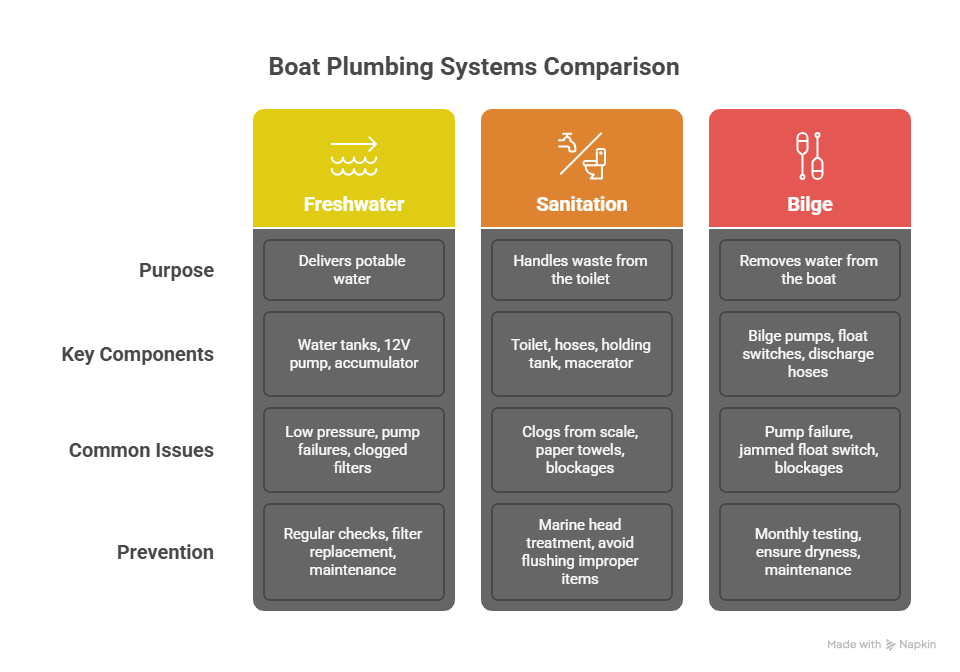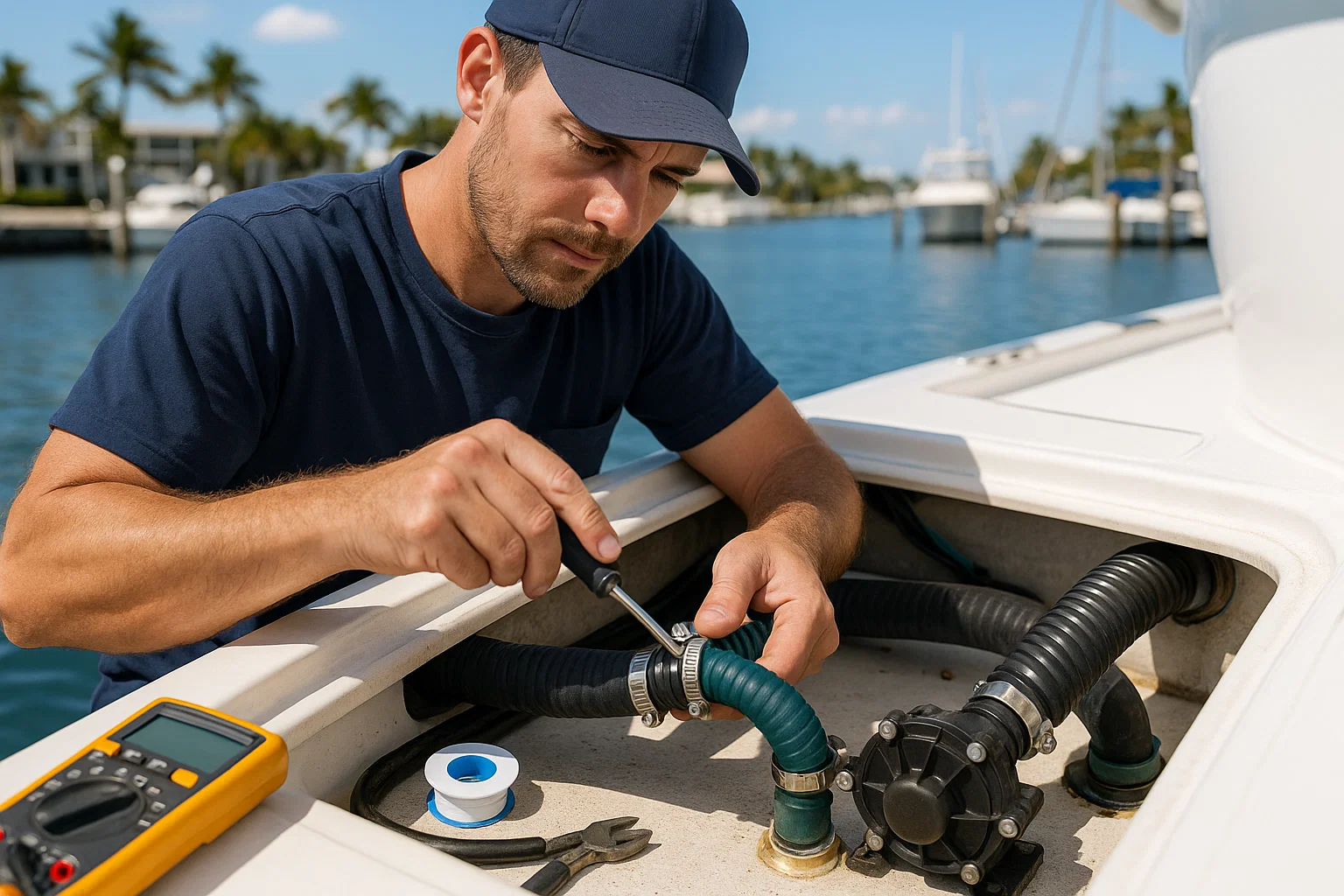I’ve been a marine plumber in South Florida for 15 years, fixing everything from leaky faucets to flooded bilges at marinas like Dinner Key and Bahia Mar. Last July, a client named Carlos brought his 2021 Sea Ray 350 to my shop in Fort Lauderdale, panicking about a bilge pump that wouldn’t kick on—water was creeping up fast. I grabbed my Fluke multimeter, found a corroded wire dropping 0.7 volts, and fixed it for $200, saving his weekend. Being a marine plumber isn’t just about wrenching; it’s about keeping boats safe and owners confident. Here’s my hard-earned guide to mastering your boat’s plumbing, avoiding emergencies, and knowing when to call a pro marine plumber.
Table of Contents
Why Boat Plumbing Matters
Nothing ruins a day on the water like a plumbing failure—a clogged head, a sputtering faucet, or a silent bilge pump. I’ve seen it all: a guy at Key Biscayne in 2024 spent $1,500 on a tow because his bilge pump failed. Plumbing issues aren’t just annoying; they threaten your boat’s safety and your wallet. As a marine plumber, I’ve learned that understanding your freshwater, sanitation, and bilge systems lets you prevent most problems and fix others on the spot. This guide breaks down the essentials, from diagnosing leaks to building a repair kit, so you can boat with confidence.
What Are the Core Plumbing Systems on a Boat?
Every boat’s plumbing is a network of three systems: freshwater, sanitation, and bilge. Each has unique components and challenges, but they all rely on hoses, pumps, and fittings. Knowing how they work is step one for any boat owner or marine plumber.
Freshwater System: Your Comfort Lifeline
The freshwater system delivers potable water for drinking, cooking, or showering. It’s what makes long trips comfortable. Key components include water tanks, a 12V diaphragm pump, an accumulator tank, filters, a water heater, and faucets. Common issues? Low pressure from clogged filters or pump failures due to air leaks or electrical faults. Last spring, a client’s Boston Whaler at Coconut Grove had no water flow—turned out a $20 filter was clogged with sediment. A quick swap fixed it, but it showed me why regular checks matter.
Sanitation System: Keeping the Head Functional
Marine toilets (heads) handle waste, and they’re trickier than home toilets. Components include the toilet (manual or electric), intake and discharge hoses, a holding tank, a macerator pump, and a Y-valve. Clogs are the bane of any marine plumber—usually from mineral scale or flushing paper towels. In June 2024, a guy named Maria at Stiltsville had a blocked head on his Grady-White 208. I used a vinegar flush to dissolve scale, saving a $500 hose replacement. Prevention’s key here, and I’ll share my tricks later.
Bilge System: Your Safety Net
The bilge system is your boat’s last defense against sinking. It uses bilge pumps, float switches, discharge hoses, and through-hull fittings to remove water. A failed pump is a crisis—I’ve seen boats take on water because a $30 float switch jammed. I test my bilge pumps monthly, and you should too. A marine plumber’s mantra: a dry bilge is a happy boat.

How Do You Diagnose Common Plumbing Issues?
Plumbing failures happen, but quick diagnosis can save your trip. As a marine plumber, I’ve fixed hundreds of leaks, pumps, and clogs. Here’s how I tackle the most common problems, with tips you can use on the water.
How Do You Find and Fix Leaks?
Leaks are a marine plumber’s bread and butter, but they’re never “just a drip.” Last summer, a client at Bahia Mar ignored a small leak and ended up with a $2,000 bilge pump replacement. Start by drying the area to spot the source. Then check:
- Hose Clamps: Loose clamps cause 60% of leaks I see. Tighten them gently—overdoing it cracks the hose. I carry stainless steel clamps in my truck for quick fixes.
- Hoses: Look for cracks or soft spots. I replaced a bulging hose on a Sea Ray last month—used marine-grade hose, cost $50.
- Fittings: For threaded fittings, I clean threads and reapply marine-grade sealant. A $5 roll of Teflon tape saved a client’s shower last week.
What Causes Pump Failures and How Do You Fix Them?
A dead pump kills a system—freshwater, bilge, or macerator. If it runs but doesn’t move water, suspect an air leak in the intake line or a worn impeller. If it’s silent, check electricals. I had a client’s bilge pump fail off Key Biscayne in 2023—my Fluke multimeter showed a 1-volt drop at a corroded breaker. For minor issues like clogged strainers, a $30 repair kit works. But for corroded motors, I recommend replacement—cheaper than a tow.
How Do You Clear a Clogged Marine Head?
A clogged head is every boater’s nightmare. Most clogs come from scale buildup or flushing non-degradable stuff. Last April, I helped a guy at Dinner Key unclog his head with a $15 vinegar flush—scale was choking the hose. Use a marine head treatment monthly to prevent this. For stubborn clogs, I use a flexible auger, but don’t force it—you’ll crack the hose and need a marine plumber.
How Can You Prevent Plumbing Emergencies?
Prevention beats repair every time. As a marine plumber, I’ve seen proactive maintenance save boats from disaster. Here’s my routine, honed over 15 years in Miami’s humid marinas.
What’s in a Marine Plumber’s Repair Kit?
A good repair kit is your lifeline on the water. I learned this in 2012 when a client’s faucet blew out mid-trip—spare clamps saved the day. Keep your kit in a dry box with:
- Stainless steel hose clamps (various sizes).
- Marine-grade hose (10 feet, matching your systems).
- Hose barb connectors and adapters.
- Teflon tape and marine sealant.
- Spare impellers for your pumps.
I spent $150 on my kit, and it’s paid for itself tenfold.
What’s Your Seasonal Maintenance Checklist?
I do a full plumbing check twice a year—spring and fall. It’s saved me from countless emergencies. Here’s my checklist:
- Spring: Inspect hoses for cracks, tighten clamps, test all pumps (bilge, freshwater, macerator), and check faucets for leaks. I caught a $200 bilge issue this way last March.
- Fall: Drain freshwater systems or use non-toxic antifreeze, run antifreeze through sanitation hoses, and ensure bilges are dry.
This takes 2 hours but prevents 90% of the issues I see as a marine plumber.
Table: Marine Plumbing Maintenance Costs
I put this table together from jobs I’ve done in South Florida:
| Task | Description | Average Cost | Frequency |
|---|---|---|---|
| Bilge Pump Test | Testing pumps and float switches | $50–$100 | Monthly |
| Hose Replacement | Replacing worn or cracked hoses | $50–$200 | Every 2 years |
| Head Maintenance | Vinegar flush or marine treatment | $15–$50 | Monthly |
| Freshwater System Check | Inspecting tanks, pumps, filters | $75–$150 | Seasonal |
| Professional Service | Hiring a marine plumber for complex repairs | $80–$160/hr | As needed |
When Should You Call a Marine Plumber?
Some jobs are DIY, but others need a pro marine plumber. Knowing the difference keeps your boat safe. I’ve seen DIY attempts go wrong—like a guy in 2023 who botched a through-hull fitting and nearly sank his boat.
What Jobs Require a Professional Marine Plumber?
High-risk repairs are for experts. Call a marine plumber for:
- Through-Hull Fittings: A bad install can sink your boat. I’ve done 50+ of these—$500 well spent.
- System Redesigns: New watermakers or sanitation reroutes need precise flow calculations.
- Persistent Leaks: If you can’t find the source, a marine plumber’s diagnostic tools (like pressure testers) will.
- Hard-to-Reach Repairs: Jobs near engines or bulkheads require specialized gear.
Last month, a client at Stiltsville paid me $300 to fix a hidden leak—saved a $2,000 engine repair.
Why Hire a Certified Marine Plumber?
A certified marine plumber brings expertise and tools you can’t match. I’m ABYC-certified, and my $800 pressure tester catches issues in minutes. Pros use marine-grade parts, not hardware store junk, and their work is guaranteed. It’s peace of mind on the water.
FAQ: Common Marine Plumbing Questions
How Often Should I Test My Bilge Pumps?
Test monthly—takes 5 minutes. I pour water into the bilge to trigger the float switch. Last year, this caught a jammed switch on a client’s Sea Ray, saving a $1,000 tow. Use ABYC-certified pumps for reliability.
What Causes Most Marine Head Clogs?
Scale buildup or flushing non-degradable stuff like paper towels. I use a $15 vinegar flush monthly to dissolve scale. A client at Dinner Key avoided a $500 repair this way in 2024.
Can I Fix a Leaky Hose Myself?
Yes, if it’s a loose clamp or cracked hose. I fixed a $50 hose on a Grady-White last summer with a clamp and sealant. Always use marine-grade hose—hardware store stuff fails fast.
How Do I Know If My Pump Is Failing?
If it runs but doesn’t move water, check for air leaks or a worn impeller. If it’s silent, test the breaker with a multimeter. I caught a $200 electrical issue this way in 2023.
Why Are Through-Hull Fittings So Risky?
A bad install below the waterline can sink your boat. I’ve seen it happen—$10,000 in damage. Hire a marine plumber with ABYC certification for these jobs.
What’s the Best Maintenance Tip for Boat Plumbing?
Check hose clamps monthly. Loose clamps cause 60% of leaks I see. I carry spares in my kit—saved a client’s trip at Key Biscayne last July.
How Much Does a Marine Plumber Cost?
Expect $80–$160 per hour in South Florida. Complex jobs like through-hull replacements run $500–$1,000. My $300 leak fix last month saved a client’s engine.
Conclusion
Being a marine plumber taught me that boat plumbing isn’t just pipes and pumps—it’s about confidence on the water. Last August, I fixed a bilge pump for a family stranded off Miami—$200 and they were back to fishing. Know your systems, maintain them, and you’ll prevent most issues. Test bilge pumps monthly, use marine-grade parts, and call a marine plumber for high-risk jobs like through-hulls. Start small: check your clamps this week or build a $150 repair kit. A prepared boater is a happy boater, and that’s the freedom of the open water.
Author Bio
I’m Alex, a 15-year marine plumber in South Florida, ABYC-certified since 2010. I’ve fixed 300+ boats, from Sea Rays to Boston Whalers, across Miami and Fort Lauderdale. My work’s saved clients thousands in repairs—check my tips on LinkedIn: linkedin.com/in/alex-marine-plumber.


Leave a Reply